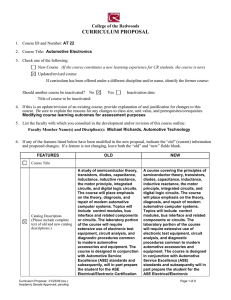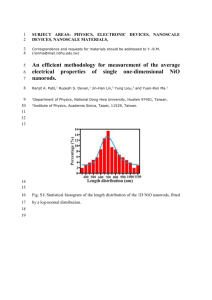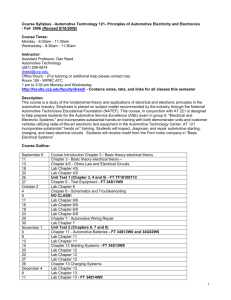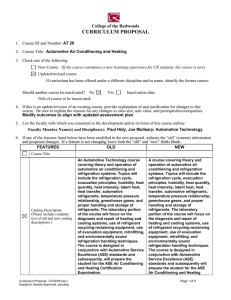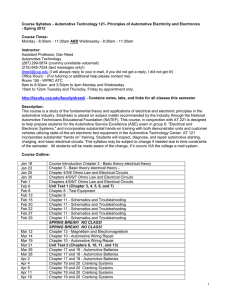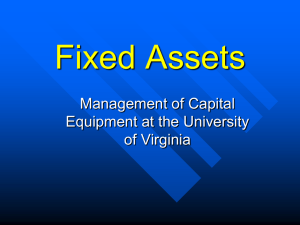CURRICULUM PROPOSAL College of the Redwoods
advertisement
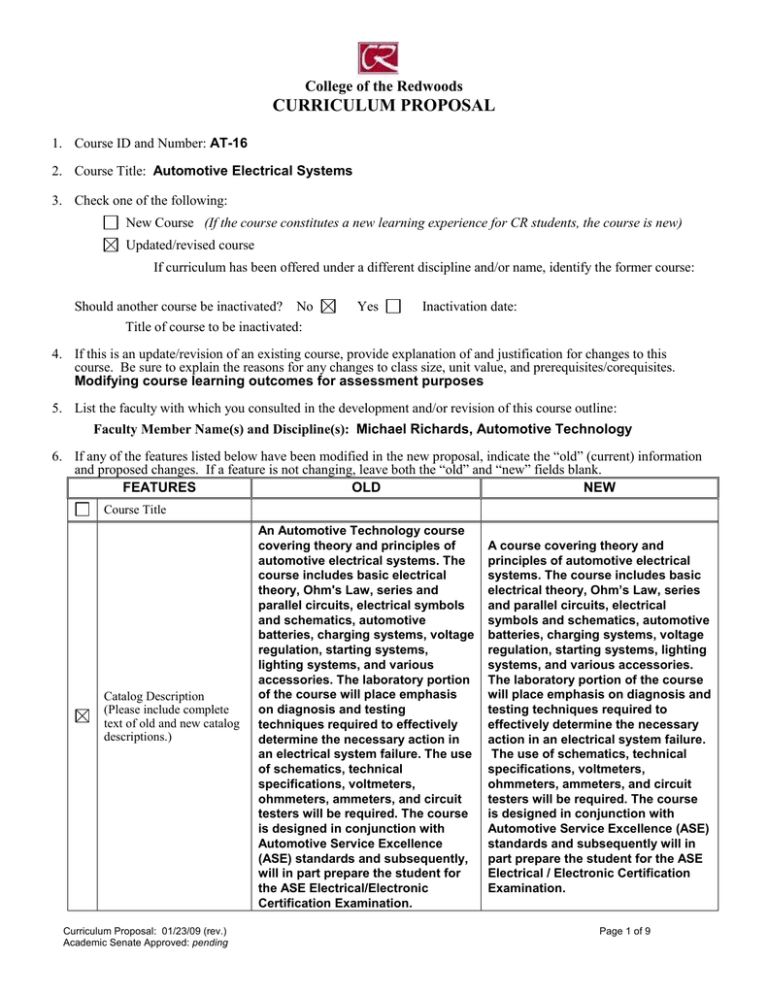
College of the Redwoods CURRICULUM PROPOSAL 1. Course ID and Number: AT-16 2. Course Title: Automotive Electrical Systems 3. Check one of the following: New Course (If the course constitutes a new learning experience for CR students, the course is new) Updated/revised course If curriculum has been offered under a different discipline and/or name, identify the former course: Should another course be inactivated? No Title of course to be inactivated: Yes Inactivation date: 4. If this is an update/revision of an existing course, provide explanation of and justification for changes to this course. Be sure to explain the reasons for any changes to class size, unit value, and prerequisites/corequisites. Modifying course learning outcomes for assessment purposes 5. List the faculty with which you consulted in the development and/or revision of this course outline: Faculty Member Name(s) and Discipline(s): Michael Richards, Automotive Technology 6. If any of the features listed below have been modified in the new proposal, indicate the “old” (current) information and proposed changes. If a feature is not changing, leave both the “old” and “new” fields blank. FEATURES OLD NEW Course Title Catalog Description (Please include complete text of old and new catalog descriptions.) Curriculum Proposal: 01/23/09 (rev.) Academic Senate Approved: pending An Automotive Technology course covering theory and principles of automotive electrical systems. The course includes basic electrical theory, Ohm's Law, series and parallel circuits, electrical symbols and schematics, automotive batteries, charging systems, voltage regulation, starting systems, lighting systems, and various accessories. The laboratory portion of the course will place emphasis on diagnosis and testing techniques required to effectively determine the necessary action in an electrical system failure. The use of schematics, technical specifications, voltmeters, ohmmeters, ammeters, and circuit testers will be required. The course is designed in conjunction with Automotive Service Excellence (ASE) standards and subsequently, will in part prepare the student for the ASE Electrical/Electronic Certification Examination. A course covering theory and principles of automotive electrical systems. The course includes basic electrical theory, Ohm’s Law, series and parallel circuits, electrical symbols and schematics, automotive batteries, charging systems, voltage regulation, starting systems, lighting systems, and various accessories. The laboratory portion of the course will place emphasis on diagnosis and testing techniques required to effectively determine the necessary action in an electrical system failure. The use of schematics, technical specifications, voltmeters, ohmmeters, ammeters, and circuit testers will be required. The course is designed in conjunction with Automotive Service Excellence (ASE) standards and subsequently will in part prepare the student for the ASE Electrical / Electronic Certification Examination. Page 1 of 9 Grading Standard Select Select Total Units Lecture Units Lab Units Prerequisites Corequisites Recommended Preparation Maximum Class Size Repeatability— Maximum Enrollments Other Curriculum Proposal: 01/23/09 (rev.) Academic Senate Approved: pending Updated CLOs Page 2 of 9 College of the Redwoods COURSE OUTLINE 1. DATE: 04-25-2011 2. DIVISION: Business and Applied Technology 3. COURSE ID AND NUMBER: AT16 4. COURSE TITLE (appears in catalog and schedule of classes): Automotive Electrical Systems 5. SHORT TITLE (appears on student transcripts; limited to 30 characters, including spaces): Automotive Electrical Systems 6. LOCAL ID (TOPS): 094800 (Taxonomy of Program codes http://www.cccco.edu/Portals/4/AA/CP%20&%20CA3/TopTax6_rev_07.doc) 7. NATIONAL ID (CIP): 47.0604 (Classification of Instructional Program codes can be found in Appendix B of the TOPS code book http://www.cccco.edu/Portals/4/AA/CP%20&%20CA3/TopTax6_rev_07.doc) 8. Discipline(s): Select from CCC System Office Minimum Qualifications for Faculty http://www.cccco.edu/SystemOffice/Divisions/AcademicAffairs/MinimumQualifications/MQsforFacultyandAdministrators/tabid/753/Default.aspx Course may fit more than one discipline; identify all that apply: Automotive Technology 9. FIRST TERM NEW OR REVISED COURSE MAY BE OFFERED: Fall 2011 10. TOTAL UNITS: 4 [Lecture Units: 2 Lab Units: 2] TOTAL HOURS: 144 [Lecture Hours: 36 Lab Hours: 108] (1 unit lecture=18 hours; 1 unit lab=54 hours) 11. MAXIMUM CLASS SIZE: 20 12. WILL THIS COURSE HAVE AN INSTRUCTIONAL MATERIALS FEE? No Yes Fee: $ (If “yes,” attach a completed “Instructional Materials Fee Request Form”—form available in Public Folders>Curriculum>Forms) GRADING STANDARD Letter Grade Only Pass/No Pass Only Is this course a repeatable lab course: No Yes Grade-Pass/No Pass Option If yes, how many total enrollments? Is this course to be offered as part of the Honors Program? No Yes If yes, explain how honors sections of the course are different from standard sections. CATALOG DESCRIPTION -- The catalog description should clearly describe for students the scope of the course, its level, and what kinds of student goals the course is designed to fulfill. The catalog description should begin with a sentence fragment. A course covering theory and principles of automotive electrical systems. The course includes basic electrical theory, Ohm’s Law, series and parallel circuits, electrical symbols and schematics, automotive batteries, charging systems, voltage regulation, starting systems, lighting systems, and various accessories. The laboratory portion of the course will place emphasis on diagnosis and testing techniques required to effectively determine the necessary action in an electrical system failure. The use of schematics, technical specifications, voltmeters, ohmmeters, ammeters, and circuit testers will be required. The course is designed in conjunction with Automotive Service Excellence (ASE) standards and subsequently will in part prepare the student for the ASE Electrical / Electronic Certification Examination. Special notes or advisories (e.g. field trips required, prior admission to special program required, etc.): PREREQUISITE COURSE(S) No Yes Course(s): Curriculum Proposal: 01/23/09 (rev.) Academic Senate Approved: pending Page 3 of 9 Rationale for Prerequisite: Describe representative skills without which the student would be highly unlikely to succeed . COREQUISITE COURSE(S) No Yes Rationale for Corequisite: Course(s): RECOMMENDED PREPARATION No Yes Course(s): MATH 120 Rationale for Recommended Preparation: Students will need a knowledge of mathematical formulas and calculations at the MATH-120 level in order to succeed in the course. COURSE LEARNING OUTCOMES –This section answers the question “what will students be able to do as a result of taking this course?” State some of the objectives in terms of specific, measurable student actions (e.g. discuss, identify, describe, analyze, construct, compare, compose, display, report, select, etc.). For a more complete list of outcome verbs please see Public Folders>Curriculum>Help Folder>SLO Language Chart. Each outcome should be numbered. 1. Diagnose general electrical system problems. 2. Diagnosis and service of battery and charging systems. 3. Diagnose and repair starting system. 4. Diagnose and repair lighting, horn, and wiper/washer systems. COURSE CONTENT–This section describes what the course is “about”-i.e. what it covers and what knowledge students will acquire Concepts: What terms and ideas will students need to understand and be conversant with as they demonstrate course outcomes? Each concept should be numbered. 1. Electrical principles, Ohm's Law, Kirchhoff's Current Laws. 2. Electrical measurements, resistance (ohms), current (amps), and voltage (volts). 3. How electricity is produced. 4. Electric motor theory and principles. 5. Ability to read and interpret electrical schematics and specifications. 6. Critical thinking skills. Issues: What primary tensions or problems inherent in the subject matter of the course will students engage? Each issue should be numbered. 1. Small group dynamics, gender, diversity, socio-economic, and multi-culturism sensitivity will be required at all times. 2. OSHA requirements for safety and health will be adhered to at all times. Themes: What motifs, if any, are threaded throughout the course? Each theme should be numbered. 1. Diagnosis by collecting and analyzing data. 2. Skills development through hands on lab experience. Skills: What abilities must students have in order to demonstrate course outcomes? (E.g. write clearly, use a scientific calculator, read college-level texts, create a field notebook, safely use power tools, etc). Each skill should be numbered. 1. Diagnose general electrical system problems. 1.1 Complete work order to include customer information, vehicle identifying information, customer concern, related service history, cause, and correction. P-1 1.2 Identify and interpret electrical/electronic system concern; determine necessary action. P-1 1.3 Research applicable vehicle and service information, such as electrical/electronic system operation, vehicle service history, service precautions, and technical service bulletins. P-1 1.4 Locate and interpret vehicle and major component identification numbers (VIN, vehicle certification labels, and calibration decals). P-1 1.5 Diagnose electrical/electronic integrity of series, parallel and series-parallel Circuits using principles of electricity (Ohm’s Law). P-1 Curriculum Proposal: 01/23/09 (rev.) Academic Senate Approved: pending Page 4 of 9 1.6 Use wiring diagrams during diagnosis of electrical circuit problems. P-1 1.7 Demonstrate the proper use of a digital multimeter (DMM) during diagnosis of Electrical circuit problems. P-1 1.8 Check electrical circuits with a test light; determine necessary action. P-2 1.9 Measure source voltage and perform voltage drop tests in electrical/electronic circuits using a voltmeter; determine necessary action. P-1 1.10 Measure current flow in electrical/electronic circuits and components using an ammeter; determine necessary action. P-1 1.11 Check continuity and measure resistance in electrical/electronic circuits and Components using an ohmmeter; determine necessary action. P-1 1.12 Check electrical circuits using fused jumper wires; determine necessary action. P-2 1.13 Locate shorts, grounds, opens, and resistance problems in electrical/electronic Circuits; determine necessary action. P-1 1.14 Measure and diagnose the cause(s) of excessive key-off battery drain (parasitic draw); determine necessary action. P-1 1.15 Inspect and test fusible links, circuit breakers, and fuses; determine necessary action. P-1 1.16 Inspect and test switches, connectors, relays, and wires of electrical/electronic circuits; perform necessary action. P-1 1.17 Remove and replace terminal end from connector. P-1 1.18 Repair connectors and terminal ends. P-1 1.19 Repair wiring harness. P-1 1.20 Perform solder repair of electrical wiring. P-1 1.21 Disarm and enable airbag system for service. P-1 2. Diagnosis and service of battery. 2.1 Perform battery state-of-charge test; determine necessary action. P-1 2.2 Perform battery capacity test (or conductance test); confirm proper battery capacity for vehicle application; determine necessary action. P-1 2.3 Maintain or restore electronic memory functions. P-1 2.4 Inspect, clean, fill, and replace battery. P-1 2.5 Perform slow/fast battery charge. P-2 2.6 Inspect and clean battery cables, connectors, clamps, and hold-downs; repair or replace as needed. P-1 2.7 Start a vehicle using jumper cables and a battery or auxiliary power supply. P-1 3. Diagnose and repair starting system. 3.1 Perform starter current draw tests; determine necessary action. P-1 3.2 Perform starter circuit voltage drop tests; determine necessary action. P-1 3.3 Inspect and test starter relays and solenoids; determine necessary action. P-2 3.4 Remove and install starter in a vehicle. P-1 3.5 Inspect and test switches, connectors, and wires of starter control circuits; perform necessary action. P-2 3.6 Differentiate between electrical and engine mechanical problems that cause a slow-crank or no-crank condition. P-2 4. Diagnose and repair charging system. 4.1 Perform charging system output test; determine necessary action. P-1 4.2 Diagnose charging system for the cause of undercharge, no-charge, and overcharge conditions. P-1 4.3 Inspect, adjust, or replace generator (alternator) drive belts, pulleys, and Curriculum Proposal: 01/23/09 (rev.) Academic Senate Approved: pending Page 5 of 9 tensioners; check pulley and belt alignment. P-1 4.4 Remove, inspect, and install generator (alternator). P-1 4.5 Perform charging circuit voltage drop tests; determine necessary action. P-1 5. Diagnose and repair lighting systems. 5.1 Diagnose the cause of brighter than normal, intermittent, dim, or no light operation; determine necessary action. P-1 5.2 Inspect, replace, and aim headlights and bulbs. P-2 5.3 Inspect and diagnose incorrect turn signal or hazard light operation; perform necessary action. P-2 5.4 Identify system voltage and safety precautions associated with high intensity discharge headlights. P-3 6. Diagnose and repair horn and wiper/washer. 6.1 Diagnose incorrect horn operation; perform necessary action. P-2 6.2 Diagnose incorrect wiper operation; diagnose wiper speed control and park problems; perform necessary action. P-2 6.3 Diagnose incorrect washer operation; perform necessary action. P-2 REPRESENTATIVE LEARNING ACTIVITIES –This section provides examples of things students may do to engage the course content (e.g., listening to lectures, participating in discussions and/or group activities, attending a field trip). These activities should relate directly to the Course Learning Outcomes. Each activity should be numbered. 1. 2. 3. 4. 5. Listening to lectures. Participating in discussions. Participating in lab/skills development activities. Researching and recording information. Writing procedures and reports. ASSESSMENT TASKS –This section describes assessments instructors may use to allow students opportunities to provide evidence of achieving the Course Learning Outcomes. Each assessment should be numbered. Representative assessment tasks (These are examples of assessments instructors could use): Required assessments for all sections (These are assessments that are required of all instructors of all sections at all campuses/sites. Not all courses will have required assessments. Do not list here assessments that are listed as representative assessments above.): 1. 2. 3. 4. Comprehensive final examination. Complete lab skills assessments. Complete periodic tests and quizzes. Homework assignments. EXAMPLES OF APPROPRIATE TEXTS OR OTHER READINGS –This section lists example texts, not required texts. Author, Title, and Date Fields are required Author James Halderman Title Author Title Date Author Title Date Author Title Date Automotive Electricity and Electronics Date 2011 Other Appropriate Readings: COURSE TYPES 1. Is the course part of a Chancellor’s Office approved CR Associate Degree? Curriculum Proposal: 01/23/09 (rev.) Academic Senate Approved: pending No Yes Page 6 of 9 If yes, specify all program codes that apply. (Codes can be found in Outlook/Public Folders/All Public Folders/ Curriculum/Degree and Certificate Programs/choose appropriate catalog year): Required course for degree(s) AUTO.AS Restricted elective for degree (s) Restricted electives are courses specifically listed (i.e. by name and number) as optional courses from which students may choose to complete a specific number of units required for an approved degree. 2. Is the course part of a Chancellor’s Office approved CR Certificate of Achievement? No Yes If yes, specify all program codes that apply. ( Codes can be found in Outlook/Public Folders/All Public Folders/ Curriculum/Degree and Certificate Programs/choose appropriate catalog year): Required course for certificate(s) AUTO.CA.ADV Restricted elective for certificate(s) Restricted electives are courses specifically listed (i.e. by name and number) as optional courses from which students may choose to complete a specific number of units required for an approved certificate. 3. Is the course Stand Alone? No Yes (If “No” is checked for BOTH #1 & #2 above, the course is stand alone) 4. Basic Skills: NBS Not Basic Skills 5. Work Experience: NWE Not Coop Work Experience 6. Course eligible Career Technical Education funding (applies to vocational and tech-prep courses only): yes 7. Purpose: I Occupational Ed 8. Accounting Method: W Weekly Census 9. Disability Status: N Not a Special Class no CURRENT TRANSFERABILITY STATUS This course is currently transferable to Neither CSU nor UC CSU as general elective credit CSU as a specific course equivalent (see below) If the course transfers as a specific course equivalent, give course number(s)/ title(s) of one or more currently-active, equivalent lower division courses from CSU. 1. Course , Campus 2. Course , Campus UC as general elective credit UC as specific course equivalent If the course transfers as a specific course equivalent, give course number(s)/ title(s) of one or more currently-active, equivalent lower division courses from UC. 1. Course , Campus 2. Course , Campus PROPOSED CSU TRANSFERABILITY (If course is currently CSU transferable, go to the next section): None General Elective Credit Specific Course Equivalent (see below) If specific course equivalent credit is proposed, give course number(s)/ title(s) of one or more currently-active, equivalent lower division courses from CSU. 1. Course , Campus Curriculum Proposal: 01/23/09 (rev.) Academic Senate Approved: pending 2. Course , Campus Page 7 of 9 PROPOSED UC TRANSFERABILITY (If course is currently UC transferable, go to the next section): None General Elective Credit OR Specific Course Equivalent (see below) If “General Elective Credit OR Specific Course Equivalent” box above is checked, give course number(s)/ title(s) of one or more currently-active, equivalent lower division courses from UC. 1. Course , Campus 2. Course , Campus CURRENTLY APPROVED GENERAL EDUCATION CR CSU IGETC CR GE Category: CSU GE Category: IGETC Category: PROPOSED CR GENERAL EDUCATION Rationale for CR General Education approval (including category designation): Natural Science Social Science Humanities Language and Rationality Writing Oral Communications Analytical Thinking PROPOSED CSU GENERAL EDUCATION BREADTH (CSU GE) A. Communications and Critical Thinking A1 – Oral Communication A2 – Written Communication A3 – Critical Thinking C. Arts, Literature, Philosophy, and Foreign Language C1 – Arts (Art, Dance, Music, Theater) C2 – Humanities (Literature, Philosophy, Foreign Language) E. Lifelong Understanding and Self-Development E1 – Lifelong Understanding E2 – Self-Development B. Science and Math B1 – Physical Science B2 – Life Science B3 – Laboratory Activity B4 – Mathematics/Quantitative Reasoning D. Social, Political, and Economic Institutions D0 – Sociology and Criminology D1 – Anthropology and Archeology D2 – Economics D3 – Ethnic Studies D5 – Geography D6 – History D7 – Interdisciplinary Social or Behavioral Science D8 – Political Science, Government and Legal Institutions D9 – Psychology Rationale for inclusion in this General Education category: Same as above Curriculum Proposal: 01/23/09 (rev.) Academic Senate Approved: pending Page 8 of 9 Proposed Intersegmental General Education Transfer Curriculum (IGETC) 1A – English Composition 1B – Critical Thinking-English Composition 1C – Oral Communication (CSU requirement only) 2A – Math 3A – Arts 3B – Humanities 4A – Anthropology and Archaeology 4B – Economics 4E – Geography 4F – History 4G – Interdisciplinary, Social & Behavioral Sciences 4H – Political Science, Government & Legal Institutions 4I – Psychology 4J – Sociology & Criminology 5A – Physical Science 5B – Biological Science 6A – Languages Other Than English Rationale for inclusion in this General Education category: Same as above Submitted by: Paul Hidy Tel. Ext. Division Chair/Director: Mike Peterson 4376 Date: 04/25/2011 Review Date: 04/26/2011 CURRICULUM COMMITTEE USE ONLY Approved by Curriculum Committee: No Academic Senate Approval Date: 5.17.11 Curriculum Proposal: 01/23/09 (rev.) Academic Senate Approved: pending Yes Date: 5.13.11 Board of Trustees Approval Date: 6.7.11 Page 9 of 9


